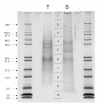The sea urchin (Strongylocentrotus purpuratus) test and spine proteomes
- PMID: 18694502
- PMCID: PMC2527298
- DOI: 10.1186/1477-5956-6-22
The sea urchin (Strongylocentrotus purpuratus) test and spine proteomes
Abstract
Background: The organic matrix of biominerals plays an important role in biomineral formation and in determining biomineral properties. However, most components of biomineral matrices remain unknown at present. In sea urchin, which is an important model organism for developmental biology and biomineralization, only few matrix components have been identified and characterized at the protein level. The recent publication of the Strongylocentrotus purpuratus genome sequence rendered possible not only the identification of possible matrix proteins at the gene level, but also the direct identification of proteins contained in matrices of skeletal elements by in-depth, high-accuracy, proteomic analysis.
Results: We identified 110 proteins as components of sea urchin test and spine organic matrix. Fourty of these proteins occurred in both compartments while others were unique to their respective compartment. More than 95% of the proteins were detected in sea urchin skeletal matrices for the first time. The most abundant protein in both matrices was the previously characterized spicule matrix protein SM50, but at least eight other members of this group, many of them only known as conceptual translation products previously, were identified by mass spectrometric sequence analysis of peptides derived from in vitro matrix degradation. The matrices also contained proteins implicated in biomineralization processes previously by inhibition studies using antibodies or specific enzyme inhibitors, such as matrix metalloproteases and members of the mesenchyme-specific MSP130 family. Other components were carbonic anhydrase, collagens, echinonectin, a alpha2-macroglobulin-like protein and several proteins containing scavenger receptor cysteine-rich domains. A few possible signal transduction pathway components, such as GTP-binding proteins, a semaphorin and a possible tyrosine kinase were also identified.
Conclusion: This report presents the most comprehensive list of sea urchin skeletal matrix proteins available at present. The complex mixture of proteins identified in matrices of the sea urchin skeleton may reflect many different aspects of the mineralization process. Because LC-MS/MS-based methods directly measures peptides our results validate many predicted genes and confirm the existence of the corresponding proteins. Considering the many newly identified matrix proteins, this proteomic study may serve as a road map for the further exploration of biomineralization processes in an important model organism.
Figures


Similar articles
-
In-depth, high-accuracy proteomics of sea urchin tooth organic matrix.Proteome Sci. 2008 Dec 9;6:33. doi: 10.1186/1477-5956-6-33. Proteome Sci. 2008. PMID: 19068105 Free PMC article.
-
Proteomic analysis of sea urchin (Strongylocentrotus purpuratus) spicule matrix.Proteome Sci. 2010 Jun 17;8:33. doi: 10.1186/1477-5956-8-33. Proteome Sci. 2010. PMID: 20565753 Free PMC article.
-
Phosphoproteomes of Strongylocentrotus purpuratus shell and tooth matrix: identification of a major acidic sea urchin tooth phosphoprotein, phosphodontin.Proteome Sci. 2010 Feb 8;8(1):6. doi: 10.1186/1477-5956-8-6. Proteome Sci. 2010. PMID: 20181113 Free PMC article.
-
Identification and developmental expression of the ets gene family in the sea urchin (Strongylocentrotus purpuratus).Dev Biol. 2006 Dec 1;300(1):35-48. doi: 10.1016/j.ydbio.2006.08.012. Epub 2006 Aug 10. Dev Biol. 2006. PMID: 16997294 Review.
-
Biomineralization of the spicules of sea urchin embryos.Zoolog Sci. 2002 Mar;19(3):253-61. doi: 10.2108/zsj.19.253. Zoolog Sci. 2002. PMID: 12125922 Review.
Cited by
-
Sea shell diversity and rapidly evolving secretomes: insights into the evolution of biomineralization.Front Zool. 2016 Jun 7;13:23. doi: 10.1186/s12983-016-0155-z. eCollection 2016. Front Zool. 2016. PMID: 27279892 Free PMC article. Review.
-
Carbonic Anhydrases in Cnidarians: Novel Perspectives from the Octocorallian Corallium rubrum.PLoS One. 2016 Aug 11;11(8):e0160368. doi: 10.1371/journal.pone.0160368. eCollection 2016. PLoS One. 2016. PMID: 27513959 Free PMC article.
-
Comparative Single-Cell Transcriptomics Reveals Novel Genes Involved in Bivalve Embryonic Shell Formation and Questions Ontogenetic Homology of Molluscan Shell Types.Front Cell Dev Biol. 2022 Jun 9;10:883755. doi: 10.3389/fcell.2022.883755. eCollection 2022. Front Cell Dev Biol. 2022. PMID: 35813198 Free PMC article.
-
Phase transitions in biogenic amorphous calcium carbonate.Proc Natl Acad Sci U S A. 2012 Apr 17;109(16):6088-93. doi: 10.1073/pnas.1118085109. Epub 2012 Apr 4. Proc Natl Acad Sci U S A. 2012. PMID: 22492931 Free PMC article.
-
The Widespread Prevalence and Functional Significance of Silk-Like Structural Proteins in Metazoan Biological Materials.PLoS One. 2016 Jul 14;11(7):e0159128. doi: 10.1371/journal.pone.0159128. eCollection 2016. PLoS One. 2016. PMID: 27415783 Free PMC article.
References
-
- Addadi L, Weiner S. Control and design principles in biological mineralization. Angew Chem Int Ed Engl. 1992;31:153–169. doi: 10.1002/anie.199201531. - DOI
-
- Weiner S, Addadi L. Design strategies in mineralized biological materials. J Mater. 1997;7:689–702.
-
- Heatfield BM, Travis DF. Ultrastructural studies of regenerating spines of the sea urchin. Strongylocentrotus purpuratus. 1975;145:13–50. - PubMed
-
- Märkel K, Röser U. The spine tissues of the echinoid Eucidaris tribuloides. Zoomorphology. 1983;103:25–41. doi: 10.1007/BF00312056. - DOI
LinkOut - more resources
Full Text Sources
Miscellaneous

